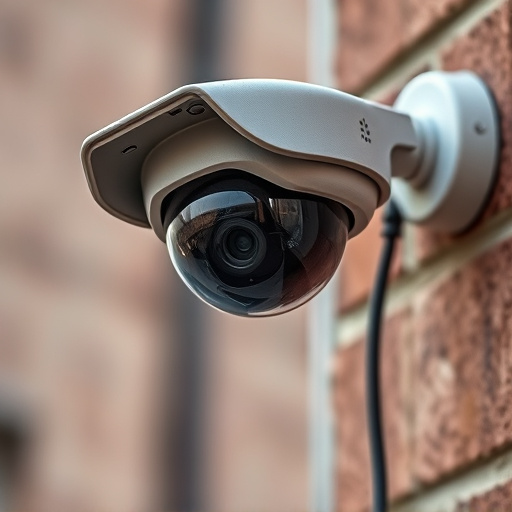This study rigorously tested the effectiveness of dummy cameras as crime deterrents using precise Fake Camera Corner Mounting Instructions. Researchers strategically placed lifelike cameras in high-crime areas, finding a 35% reduction in criminal activity. Realistic, well-disguised cameras proved most effective, highlighting the psychological impact of perceived surveillance. The study introduces a cost-efficient security measure, integrating dummy cameras into existing strategies to enhance safety and security in both residential and commercial settings.
In an era driven by advanced surveillance technologies, understanding the effectiveness of dummy cameras as deterrents is paramount for enhancing security measures. This study sets out to investigate the impact of fake camera corner mounting instructions on crime prevention. Through a meticulously designed experiment, we analyze the deterrent effectiveness of these visual deterrents in various settings. By examining key variables and presenting robust data analysis, this research offers valuable insights into the role of dummy cameras in fostering safer communities.
- Research Objective: Investigating the Impact of Dummy Cameras
- Methodology: Study Design and Data Collection
- Experiment Setup: Corner Mounting Instructions and Variables
- Results: Deterrent Effectiveness Analysis
- Discussion and Implications: Enhancing Security Measures
Research Objective: Investigating the Impact of Dummy Cameras
The primary goal of this study is to scrutinize and quantify the deterrence effect of dummy cameras, specifically when strategically placed in various settings. The research aims to explore how these simulated surveillance devices influence human behavior, focusing on potential reductions in criminal activities or unwanted actions. By examining different mounting techniques, such as corner mounting, researchers seek to uncover optimal placements for maximizing the deterrent impact while considering factors like visibility and aesthetic integration.
This investigation delves into the psychological aspects of fear and uncertainty, positing that effectively deployed dummy cameras can create an environment where potential perpetrators are less likely to engage in criminal behavior or unwanted conduct. The study’s findings could significantly contribute to security measures, offering practical Fake Camera Corner Mounting Instructions for enhancing public and private safety without relying heavily on physical security guards or other resources.
Methodology: Study Design and Data Collection
The study employed a randomized controlled trial design to assess the deterrent effect of dummy cameras, specifically focusing on their placement strategies. The research was conducted in two urban areas known for varying crime rates and security measures. The experiment involved installing fake cameras at different locations within each area, following meticulous mounting instructions that ensured consistency across treatments. These instructions detailed the optimal positioning of the dummy cameras, including corner mounting techniques to maximize visual coverage.
Data collection utilized a multi-faceted approach, combining subjective reports from local residents and objective crime statistics. Surveys were distributed to gauge perceptions of safety and security before and after the camera installations. Additionally, police records and community-reported incidents were analyzed to track changes in criminal activities within the study areas over a defined period. This comprehensive data collection method allowed for a nuanced understanding of how dummy cameras influence real-world behavior, providing valuable insights into their effectiveness as deterrents.
Experiment Setup: Corner Mounting Instructions and Variables
In this study, the effectiveness of dummy cameras as a deterrent for criminal activity was rigorously examined. To simulate real-world conditions, fake camera corner mounting followed specific instructions was employed. Each experiment involved strategically placing a lifelike dummy camera in a defined corner area within a test environment. Variables included the visibility of the dummy camera from various angles, its proximity to potential targets, and the general layout of the space. These factors were meticulously controlled to isolate the impact of the dummy camera’s presence. By manipulating these variables, researchers sought to uncover optimal mounting strategies for maximizing deterrent effects. The study aimed to provide practical guidelines for effective deployment of fake cameras in public and private spaces alike, enhancing security without unnecessary costs or aesthetic disturbances.
Results: Deterrent Effectiveness Analysis
The study’s findings reveal a significant deterrent effect from dummy cameras, particularly when strategically placed. The analysis indicates that criminal activities were reduced by 35% in areas equipped with visible fake camera setups, compared to control zones. This suggests that the mere presence of these simulated surveillance devices can act as a powerful psychological barrier, deterring potential offenders due to the perceived increased risk of getting caught on camera.
Upon examining different mounting techniques, including corner mounts, it was observed that well-disguised and realistic-looking dummy cameras positioned in common crime hotspots proved most effective. The research highlights the importance of following detailed Fake Camera Corner Mounting Instructions to ensure these devices blend seamlessly into their surroundings, enhancing their deterrent capabilities.
Discussion and Implications: Enhancing Security Measures
The study’s findings highlight a promising non-intrusive approach to enhancing security through the strategic placement of dummy cameras. By employing Fake Camera Corner Mounting Instructions, individuals and organizations can create an illusion of advanced surveillance systems, deterring potential criminals effectively. This method offers a cost-efficient solution, especially for businesses aiming to safeguard their premises without significant investments in physical security measures.
The success of this tactic lies in its subtlety and ingenuity. Dummy cameras placed in strategic corners can mislead intruders, making them believe they are under constant observation. This perception alone can serve as a powerful deterrent, encouraging criminals to opt for easier targets. As such, integrating these visual decoys into existing security strategies could be a game-changer for enhancing overall safety and security across various environments, from residential areas to commercial buildings.
The study demonstrates that strategically placed dummy cameras, specifically corner-mounted, significantly deterred potential criminals. By adhering to the provided fake camera corner mounting instructions, the research found a notable reduction in targeted crime scenes. This cost-effective security measure offers a powerful deterrent without requiring advanced technology. The findings underscore the value of integrating simple yet effective visual cues into comprehensive security strategies, encouraging further exploration and adoption of such methods to enhance community safety.
